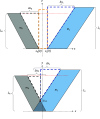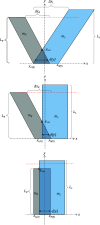Asymmetric triangular body-cover model of the vocal folds with bilateral intrinsic muscle activation
- PMID: 39133633
- PMCID: PMC11748384
- DOI: 10.1121/10.0028164
Asymmetric triangular body-cover model of the vocal folds with bilateral intrinsic muscle activation
Abstract
Many voice disorders are linked to imbalanced muscle activity and known to exhibit asymmetric vocal fold vibration. However, the relation between imbalanced muscle activation and asymmetric vocal fold vibration is not well understood. This study introduces an asymmetric triangular body-cover model of the vocal folds, controlled by the activation of bilateral intrinsic laryngeal muscles, to investigate the effects of muscle imbalance on vocal fold oscillation. Various scenarios were considered, encompassing imbalance in individual muscles and muscle pairs, as well as accounting for asymmetry in lumped element parameters. Measurements of amplitude and phase asymmetries were employed to match the oscillatory behavior of two pathological cases: unilateral paralysis and muscle tension dysphonia. The resulting simulations exhibit muscle imbalance consistent with expectations in the composition of these voice disorders, yielding asymmetries exceeding 30% for paralysis and below 5% for dysphonia. This underscores the relevance of muscle imbalance in representing phonatory scenarios and its potential for characterizing asymmetry in vocal fold vibration.
© 2024 Acoustical Society of America.
Conflict of interest statement
Carlos Calvache has financial interests in Vocology Center, a company focused on vocal rehabilitation processes, professional voice training, and continuing education in the field of spoken, sung, and interpreted voice. Carlos Calvache's interests were reviewed and are managed by Corporación Universitaria Iberoamericana, Bogotá, Colombia, in accordance with its conflict-of-interest policies. Matías Zañartu has financial interest in Lanek SPA, a company focused on developing and commercializing biomedical devices and technologies. Matías Zañartu's interests were reviewed and are managed by Universidad Técnica Federico Santa María in accordance with its conflict-of-interest policies.
Figures











Update of
-
Asymmetric triangular body-cover model of the VFs with bilateral intrinsic muscle activation.bioRxiv [Preprint]. 2024 Mar 20:2024.03.18.585590. doi: 10.1101/2024.03.18.585590. bioRxiv. 2024. Update in: J Acoust Soc Am. 2024 Aug 1;156(2):939-953. doi: 10.1121/10.0028164. PMID: 38562893 Free PMC article. Updated. Preprint.
References
-
- Birkholz, P. (2016). “ Glottalimageexplorer an open source tool for glottis segmentation in endoscopic high-speed videos of the vocal folds,” in Studientexte Zur Sprachkommunikation: Elektronische Sprachsignalverarbeitung 2016, edited by Jokisch O. ( TUDpress, Dresden: ), pp. 39–44.
-
- Birkholz, P., Kröger, B. J., and Neuschaefer-Rube, C. (2011). “ Synthesis of breathy, normal, and pressed phonation using a two-mass model with a triangular glottis,” in Interspeech 2011: 12th Annual Conference of the International Speech Communication Association, Florence, Italy, pp. 2681–2684.
Publication types
MeSH terms
Grants and funding
LinkOut - more resources
Full Text Sources

